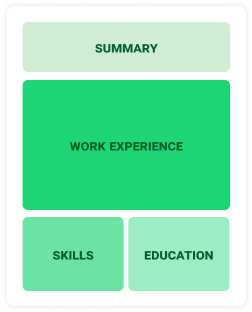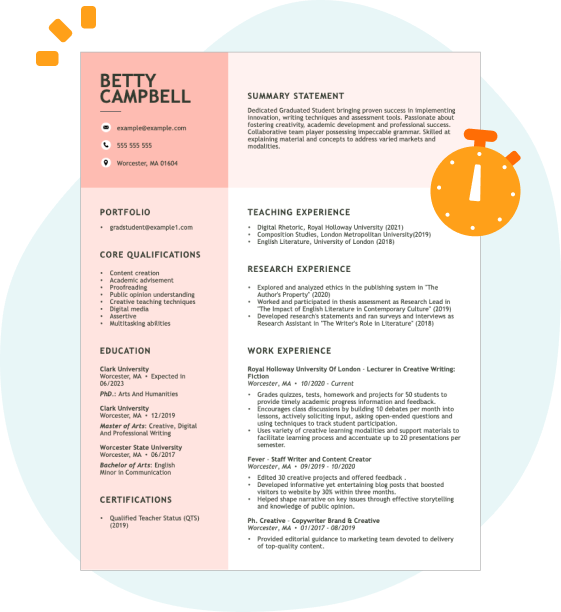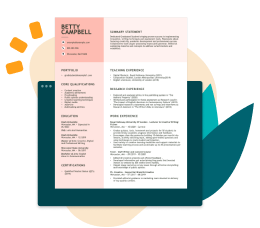Hard skills include expertise in risk assessment methodologies, knowledge of regulatory compliance, and the ability to analyze financial data related to third-party services.
Popular Third Party Risk Analyst Resume Examples
Discover our top third-party risk analyst resume examples that emphasize critical skills such as risk assessment, data analysis, and regulatory compliance. These resumes effectively highlight your strengths and accomplishments in the field.
Ready to build your ideal resume? Our Resume Builder offers user-friendly templates specifically designed for professionals in risk management, helping you make a strong impression on potential employers.
Entry-level third party risk analyst resume
This entry-level resume effectively highlights the job seeker's analytical skills and achievements in vendor risk assessment. New professionals in this field must demonstrate their ability to analyze data, manage compliance, and showcase relevant certifications to attract employer interest despite limited work experience.
Mid-career third party risk analyst resume
This resume showcases essential qualifications by clearly outlining achievements and skills relevant to third party risk management. The structured presentation of responsibilities and accomplishments signals the applicant's readiness for advanced roles, highlighting a trajectory of increasing impact and leadership within the field.
Experienced third party risk analyst resume
This resume's work experience section demonstrates the applicant's strong background in third-party risk management, showcasing their success in reducing risk exposure by 20% and improving compliance rates by 30%. The clear bullet-point format improves readability, making it easy for hiring managers to identify key achievements quickly.
Resume Template—Easy to Copy & Paste
Hank Green
Eastside, WA 98002
(555)555-5555
Hank.Green@example.com
Professional Summary
Seasoned Third Party Risk Analyst with 9 years' experience in vendor risk management, compliance verification, and risk mitigation strategies. Proven ability in reducing incident rates and enhancing vendor accuracy scoring. Expert in risk reporting and supply chain analysis.
Work History
Third Party Risk Analyst
Global Security Solutions - Eastside, WA
May 2022 - October 2025
- Assessed risk for 85 vendor contracts annually
- Developed risk mitigation strategies that cut incidents by 25%
- Validated vendor compliance with industry standards
Vendor Risk Management Analyst
SecureTech Inc. - Seattle, WA
January 2018 - April 2022
- Conducted due diligence on 50+ vendors per quarter
- Enhanced vendor scoring system, improving accuracy by 30%
- Collaborated with departments to reduce vendor risk exposure
Supply Chain Risk Analyst
Innovative Risk Solutions - Spokane, WA
January 2016 - December 2017
- Evaluated supply chain risks for 300+ vendors
- Implemented monitoring tools that detected 40 issues/year
- Created comprehensive risk reports for executive team
Skills
- Third Party Risk Assessment
- Vendor Management
- Compliance Verification
- Risk Mitigation Strategies
- Risk Reporting
- Due Diligence
- Incident Reduction
- Supply Chain Analysis
Certifications
- Certified Third Party Risk Professional (CTPRP) - Risk Management Society
- Certified Information Security Manager (CISM) - ISACA
Education
Master of Science Risk Management
Stanford University Stanford, CA
May 2014
Bachelor of Science Business Administration
University of California, Berkeley Berkeley, CA
May 2012
Languages
- Spanish - Beginner (A1)
- French - Intermediate (B1)
- German - Beginner (A1)
How to Write a Third Party Risk Analyst Resume Summary
Your resume summary is the first impression you make on hiring managers, making it important to showcase your qualifications effectively. As a third-party risk analyst, it's important to highlight your analytical skills and experience in assessing vendor risks to stand out in this competitive field.
This profession should emphasize your ability to identify potential threats and develop strategies for risk mitigation. Showcasing certifications and relevant accomplishments will add weight to your profile.
To help you understand what makes a strong resume summary, here are some examples that illustrate effective techniques and common pitfalls:
Weak resume summary
I am a dedicated third party risk analyst with extensive experience in assessing vendor risks. I seek a position where I can apply my analytical skills and contribute to the company’s success. A role that offers professional development and a supportive environment is what I desire. I believe my background can be valuable to your team.
- Lacks specific examples of skills or achievements relevant to third party risk analysis
- Overuses personal pronouns and vague statements, making it feel less compelling
- Prioritizes the applicant’s desires over how they can benefit the organization
Strong resume summary
Results-driven Third Party Risk Analyst with 7+ years of experience in managing vendor risk assessments and compliance. Successfully reduced third-party data breach incidents by 20% through improved risk monitoring strategies. Proficient in using risk management software, conducting thorough due diligence, and collaborating with cross-functional teams to ensure regulatory adherence.
- Begins with a clear statement of experience and specialization within risk analysis
- Highlights a measurable achievement that showcases the job seeker’s impact on reducing risks
- Includes technical skills and competencies relevant to third party risk management roles
PRO TIP
Showcasing Your Work Experience
The work experience section is important on your resume as a third party risk analyst, where you will present the majority of your content. Good resume templates are designed to prioritize this section, helping you stand out.
This section should be organized in reverse-chronological order, listing previous positions first. Bullet points can effectively highlight key achievements and contributions relevant to third party risk management in each role.
We’ll provide a couple of entries to illustrate effective work history examples that show what works well and avoid potential pitfalls.
Third Party Risk Analyst
Global Finance Inc. – New York, NY
- Assessed vendor risks
- Reviewed contracts and compliance documents
- Collaborated with teams on risk evaluations
- Created reports and shared findings
- Lacks specific dates of employment
- Bullet points do not highlight any measurable impact or achievements
- Focuses on routine tasks instead of showcasing analytical skills or contributions
Third Party Risk Analyst
Global Finance Solutions – New York, NY
March 2020 - Current
- Conduct comprehensive risk assessments on over 50 third-party vendors annually, ensuring compliance with company policies and regulatory standards
- Develop and implement a vendor risk management framework that reduced potential risks by 30% in the first year
- Collaborate with cross-functional teams to improve risk mitigation strategies, leading to a 15% decrease in audit findings related to third-party engagements
- Uses strong action verbs to clearly outline the job seeker's contributions and impact
- Incorporates quantifiable achievements that highlight effectiveness and improvements made
- Demonstrates relevant skills such as compliance, assessment, and collaboration essential for the role
While the resume summary and work experience are important to your application, don’t overlook other important sections that improve your profile. For more detailed guidance on assembling a standout resume, be sure to explore our comprehensive guide on how to write a resume.
Top Skills to Include on Your Resume
A well-defined skills section is important for any resume, as it highlights your qualifications at a glance. This area allows you to showcase your competencies and directly align them with the job requirements.
Employers want candidates who bring both technical know-how and strong people skills to the table. As you write your resume, make sure to highlight a balanced mix of hard and soft skills that reflect your full professional strengths.
Soft skills encompass critical thinking, effective communication, and collaboration, which are essential for navigating complex risks and fostering strong relationships with stakeholders.
When selecting skills for your resume, it’s important to align with what employers expect. Many organizations use automated screening systems that filter out applicants lacking essential resume skills, so ensuring your qualifications match is key.
To improve your chances of getting noticed, review job postings for insights into which resume skills are in demand. Highlighting these specific abilities will help you stand out to both recruiters and ATS systems.
PRO TIP
10 skills that appear on successful third party risk analyst resumes
Highlighting sought-after skills on your resume can significantly attract the attention of recruiters looking for third party risk analysts. You can find these skills illustrated in our resume examples, ensuring you present yourself with the confidence that a polished resume provides.
Here are 10 essential skills you should consider incorporating into your resume if they align with your qualifications and job criteria:
Risk assessment
Analytical thinking
Attention to detail
Communication skills
Regulatory knowledge
Problem-solving abilities
Project management
Data analysis
Interpersonal skills
Technical skills
Based on analysis of 5,000+ insurance professional resumes from 2023-2024
Resume Format Examples
Choosing the right resume format is important for a third party risk analyst, as it showcases your analytical skills and experience in a clear, organized manner that highlights your career growth.
Functional
Focuses on skills rather than previous jobs

Best for:
Recent graduates and career changers with limited experience
Combination
Balances skills and work history equally

Best for:
Mid-career professionals focused on demonstrating their skills and potential for growth
Chronological
Emphasizes work history in reverse order

Best for:
Seasoned analysts with expertise in risk management and strategic oversight
Frequently Asked Questions
Should I include a cover letter with my third party risk analyst resume?
Absolutely, including a cover letter is a great way to showcase your qualifications and enthusiasm for the position. A well-crafted cover letter allows you to elaborate on your skills and experiences while making a personal connection with the hiring manager. For tips on writing an effective cover letter, check out our comprehensive guide on how to write a cover letter. Alternatively, use our Cover Letter Generator for quick assistance.
Can I use a resume if I’m applying internationally, or do I need a CV?
When applying for jobs internationally, use a CV instead of a resume, as many countries prefer this format. A CV provides a comprehensive view of your academic and professional history. Explore our resources on how to write a CV and review various CV examples to ensure your application stands out.
What soft skills are important for third party risk analysts?
Soft skills such as critical thinking, communication, and collaboration are essential for third party risk analysts. These interpersonal skills enable effective relationship-building with vendors and stakeholders, ensuring thorough assessments and fostering a proactive approach to managing risks.
I’m transitioning from another field. How should I highlight my experience?
Highlight your transferable skills like analytical thinking, risk assessment, and communication when applying for a third party risk analyst position. These capabilities are essential in evaluating risks and making informed decisions. Incorporate concrete examples from prior roles to show how you've successfully managed challenges that align with the responsibilities of this new role.
How should I format a cover letter for a third party risk analyst job?
To properly format a cover letter, start by placing your name and contact details at the top. This should be followed by a professional greeting. In the opening paragraph, capture attention by linking your experience to the job. Include a concise summary of relevant skills and finish with a strong call to action, prompting the employer to reach out for an interview.
How do I add my resume to LinkedIn?
To improve your visibility as a third party risk analyst on LinkedIn, you should add your resume to LinkedIn or highlight key skills in the "About" and "Experience" sections. This approach helps recruiters easily identify qualified applicants, making it simpler for you to connect with relevant job opportunities.







